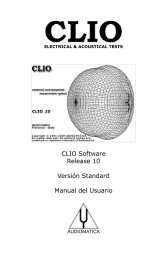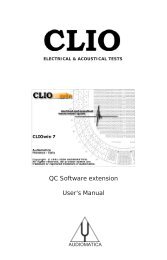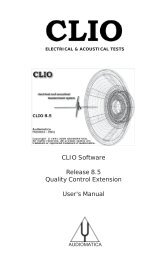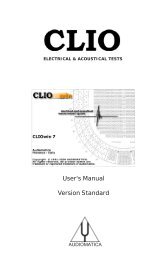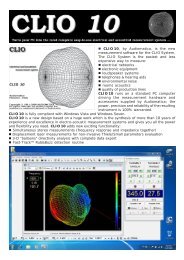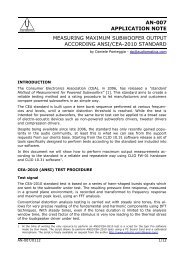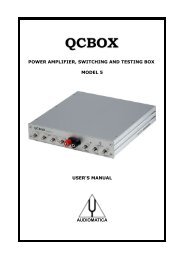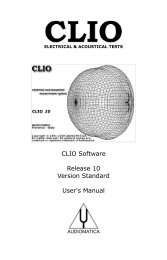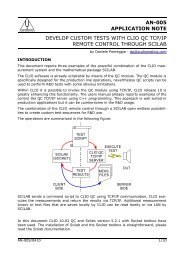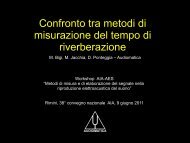CLIOwin 6.5 PCI User's Manual - Audiomatica Srl
CLIOwin 6.5 PCI User's Manual - Audiomatica Srl
CLIOwin 6.5 PCI User's Manual - Audiomatica Srl
Create successful ePaper yourself
Turn your PDF publications into a flip-book with our unique Google optimized e-Paper software.
utton. Any process you execute can be saved to disk and will have "mpro" extension.<br />
This allows to recall any value or file path later on by loading this file again. Suppose<br />
you have a little production of ten speakers you want to test against a previous produced<br />
reference you know is fine. You just have to define and save a process that divide current<br />
data with the reference. Testing a device against itself should produce a flat line, within<br />
the frequency range of the device, and this should be checked before saving the<br />
process. When you need to check your little batch you just recall your process. This will<br />
activate the Automatic Process button. When this button is down any subsequent<br />
measurement is processed before it is displayed. The next process we will consider is<br />
the dBSPL/Watt. It requires a file and an impedance value and allows to obtain a<br />
frequency response plot referred to 1W at the speaker terminal whatever is the real<br />
measurement level. To make this possible an electrical measurement at the speaker<br />
terminal (power amplifier output) must be taken, with dBV as y-scale, and used as<br />
reference file. A value of impedance is also necessary that allows Clio to convert voltage<br />
to power. We will go trough the entire procedure using the tweeter of previous<br />
examples. As what we are looking for is the response in 1W-1m condition we have to<br />
move the microphone to 1m from the tweeter (it was at 69.14cm). The 1m condition<br />
can be set directly with a meter. Fig.10.32 shows the 1m measure in black and the<br />
previous one in red. Level at speaker terminal is unchanged. The average difference<br />
3.3dB.<br />
110.0<br />
CLIO<br />
180.0<br />
30.0<br />
CLIO<br />
180.0<br />
dBSPL<br />
Deg<br />
dBV<br />
Deg<br />
100.0 108.0<br />
20.0 108.0<br />
90.0 36.0<br />
10.0 36.0<br />
80.0 -36.0<br />
0.0 -36.0<br />
70.0 -108.0<br />
-10.0 -108.0<br />
60.0 -180.0<br />
20 Hz<br />
100 1k 10k 20k<br />
-20.0 -180.0<br />
20 Hz<br />
100 1k 10k 20k<br />
Figure 10.32 and 10.33<br />
We now connect Clio input to the speaker terminals, change the y-scale to dBV, do not<br />
change Clio output level and obtain Fig.10.33. This is a nearly flat line that indicates<br />
us the voltage delivered to the speaker. Remember to save the measurement to disk.<br />
It is worth to point out that deviation from linearity in this curve due to the power amp<br />
or cable would be compensated by this procedure. Now we reload the response at 1m,<br />
go to the Process Dialog that will appear as in Fig.10.34.<br />
Figure 10.34<br />
102 Chapter 10 - MLS




